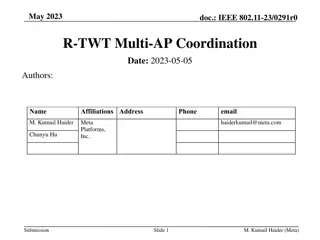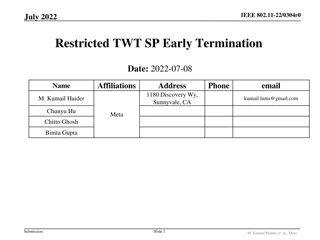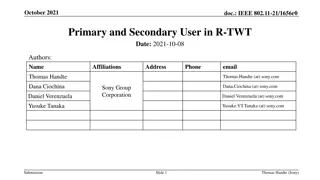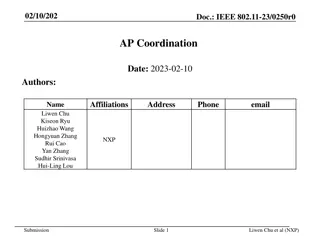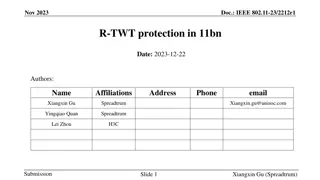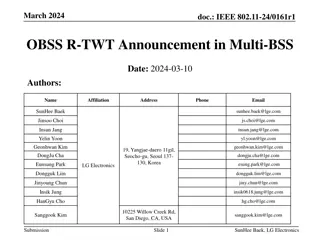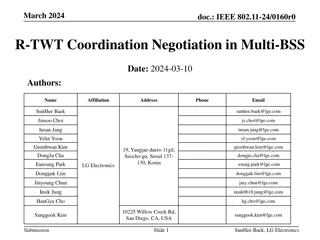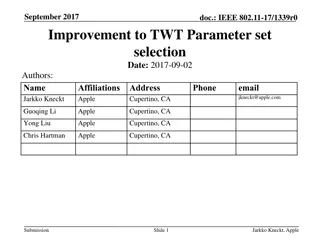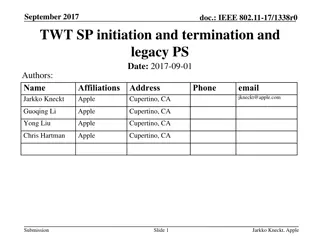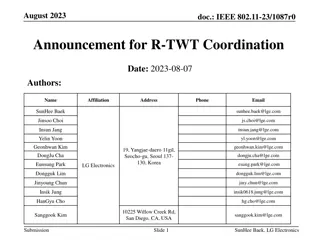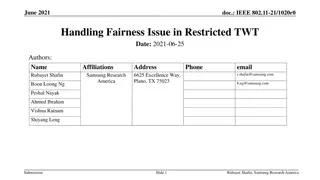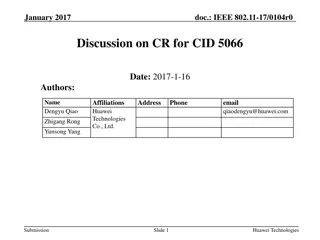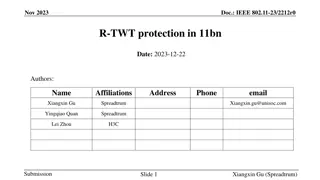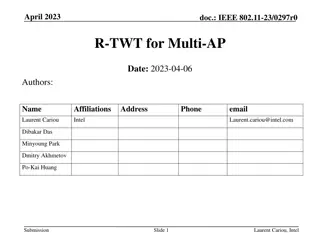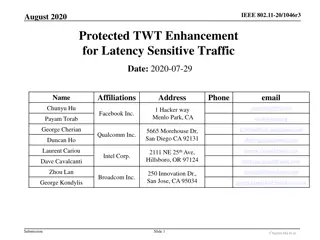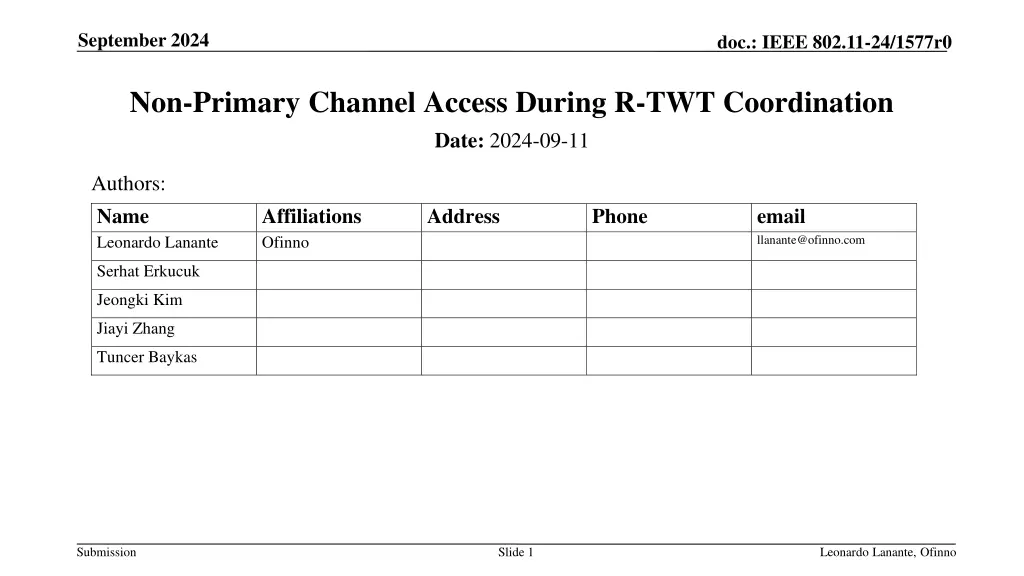
Improving Network Performance with R-TWT Coordination
Enhance network performance with R-TWT coordination addressing overprotection of OBSS R-TWT SPs through Non-Primary Channel Access (NPCA) for efficient transmission in secondary channels, even when the primary channel is busy. Learn about R-TWT SPs, NPCA functionality, and coordination levels between APs to optimize latency and network efficiency.
Download Presentation

Please find below an Image/Link to download the presentation.
The content on the website is provided AS IS for your information and personal use only. It may not be sold, licensed, or shared on other websites without obtaining consent from the author. If you encounter any issues during the download, it is possible that the publisher has removed the file from their server.
You are allowed to download the files provided on this website for personal or commercial use, subject to the condition that they are used lawfully. All files are the property of their respective owners.
The content on the website is provided AS IS for your information and personal use only. It may not be sold, licensed, or shared on other websites without obtaining consent from the author.
E N D
Presentation Transcript
September 2024 doc.: IEEE 802.11-24/1577r0 Non-Primary Channel Access During R-TWT Coordination Date: 2024-09-11 Authors: Name Leonardo Lanante Affiliations Ofinno Address Phone email llanante@ofinno.com Serhat Erkucuk Jeongki Kim Jiayi Zhang Tuncer Baykas Submission Slide 1 Leonardo Lanante, Ofinno
September 2024 doc.: IEEE 802.11-24/1577r0 Abstract R-TWT Coordination is a candidate feature for improving the network performance of multiple BSSs in terms of latency. In R-TWT coordination, APs and/or STAs may need to terminate their TXOPs prior to the start of an R-TWT service period scheduled by an OBSS AP. In [1], the authors addressed the issue of overprotection of OBSS R-TWT SPs by reducing TXOP terminations for OBSS R-TWT SPs. In this contribution, we provide further considerations regarding overprotection of OBSS R-TWT SPs in regard to NPCA. Submission Slide 2 Leonardo Lanante, Ofinno
September 2024 doc.: IEEE 802.11-24/1577r0 Non Primary Channel Access NPCA allows transmissions in the secondary channel even if the primary channel is busy. If the designated secondary channel(s) are available (also called the NPCA channel), an AP/STA transmits on the available secondary channel(s) frequency Busy (STA to AP or AP to STA) Secondary 40MHz 40MHz PPDU Busy 60MHz PPDU 80MHz PPDU Busy Secondary 20MHz 40MHz PPDU (interference, OBSS) 20MHz PPDU (interference, OBSS) Primary 20MHz time STA can transmit a packet on the secondary channels while the primary channel is busy Submission Slide 3 Leonardo Lanante, Ofinno
September 2024 doc.: IEEE 802.11-24/1577r0 R-TWT SPs AP1 Frame exchanges AP 1 R-TWT SP 1 AP2 Frame exchanges Frame AP 2 R-TWT SP 1 TGbn may support R-TWT schedule coordination between APs. There may be multiple levels of coordination: In the most restrictive case, one coordinating AP (e.g. AP 1) and STAs associated to the coordinating AP end their TXOP at the SP (e.g. R-TWT SP1) start boundary as if the R-TWT SP is scheduled by the coordinating AP. In a less restrictive case, only APs (e.g. AP 1) end their TXOP at the SP start boundary. Submission Slide 4 Leonardo Lanante, Ofinno
September 2024 doc.: IEEE 802.11-24/1577r0 NPCA at the R-TWT Start Boundary AP1 Frame exchanges NPCA PCH (AP1) PCH OBSS Tx AP 1 NPCA PCH (AP 1) AP2 Frame exchanges PCH Frame R-TWT SP 1 AP 2 R-TWT SP 1 When an OBSS transmission is detected by AP1 near the start of a coordinated R-TWT, AP 1 may want to terminate the TXOP in the NPCA primary channel. This gives the frame exchange by AP 2 in the R-TWT SP better protection. For example, if the bandwidth of the frame exchange includes the NPCA channel. Submission Slide 5 Leonardo Lanante, Ofinno
September 2024 doc.: IEEE 802.11-24/1577r0 Overprotection of R-TWT SP AP1 Frame exchanges NPCA PCH (AP1) PCH OBSS Tx AP 1 NPCA PCH (AP 1) Unused AP2 Frame exchanges PCH Frame R-TWT SP 1 AP 2 R-TWT SP 1 However, in some cases terminating the NPCA TXOP during a coordinated R-TWT SP may be unnecessary. For example, if the AP 2 frame exchange does not use the NPCA channel. Another example, is if AP 2 hears the same OBSS transmission, AP 2 will only be able to transmit after the OBSS transmission. In both cases, there is no need to terminate the NPCA TXOP. Submission Slide 6 Leonardo Lanante, Ofinno
September 2024 doc.: IEEE 802.11-24/1577r0 Proposal One possible solution is to include the bandwidth of frame exchanges to be done in a coordinated R-TWT SP. An AP may set the NPCA channel not to overlap with the coordinated R-TWT SP bandwidth. An AP may then continue its NPCA TXOP without termination at the coordinated R-TWT SP boundary. AP1 Frame exchanges NPCA CH PCH OBSS Tx AP 1 R-TWT SP 1 Bandwidth NPCA CH AP2 Frame exchanges frame PCH AP 2 R-TWT SP 1 Submission Slide 7 Leonardo Lanante, Ofinno
September 2024 doc.: IEEE 802.11-24/1577r0 Discussion An AP receiving a request for R-TWT SP coordination may accept or reject the request based on the requested R-TWT SP protection bandwidth. Another possible (and simpler) solution is to make an exception for NPCA TXOPs not to terminate the TXOP during coordinated R-TWT SP. - Equivalent to a R-TWT SP protection bandwidth of 20 MHz. Submission Slide 8 Leonardo Lanante, Ofinno
September 2024 doc.: IEEE 802.11-24/1577r0 DSO at the R-TWT Start Boundary The same idea can be applied for DSO at the R-TWT start boundary. AP1 Frame exchanges (cont) ICR ICF ICF SCH AP1 Frame exchanges PCH AP 1 R-TWT SP 1 Bandwidth SCH AP2 Frame exchanges frame PCH AP 2 R-TWT SP 1 Submission Slide 9 Leonardo Lanante, Ofinno
September 2024 doc.: IEEE 802.11-24/1577r0 Conclusion NPCA TXOPs may be subject to TXOP termination during R-TWT SP start boundaries. We showed that in some cases, TXOP termination may be unnecessary. We proposed to signal a protection bandwidth for coordinated R-TWT SPs for APs to know whether it may continue its NPCA TXOP at the R-TWT SP start boundary. Submission Slide 10 Leonardo Lanante, Ofinno
September 2024 doc.: IEEE 802.11-24/1577r0 References 1. https://mentor.ieee.org/802.11/dcn/24/11-24-1206-01-00bn-considerations- on-coordinated-r-twt.pptx 2. https://mentor.ieee.org/802.11/dcn/24/11-24-1154-00-00bn-discussion-on- coordination-of-twt.pptx Submission Slide 11 Leonardo Lanante, Ofinno

